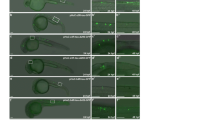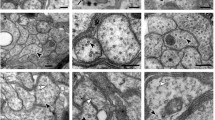Abstract
Although tau filament formation is a central event in familial tauopathies and Alzheimer’s disease (AD), the cellular consequences of neurofibrillary tangle (NFT) formation are poorly understood because of the unavailability of mammalian in vivo cellular models of neurofibrillary degeneration (NFD). We have shown that human tau forms filaments and is associated with cytodegeneration when overexpressed chronically in identified neurons (ABCs) in the lamprey central nervous system (CNS). In this model, degeneration occurs according to a stereotyped sequence that closely resembles the pattern seen in tangle-bearing neurons in AD, with both tau deposition and fragmentation beginning in distal dendrites and progressing proximally over time. This sequence has been divided into four stages ranging from (1) mild beading of terminal dendrites only through (4) extensive dendritic fragmentation and loss. Here, we show that lipid-soluble, low-molecular-weight (approx 300 Da) proprietary compounds that have been demonstrated to block tau filament formation in vitro can significantly retard the progressive degeneration of ABCs that express human tau23. Bath application of one of these compounds for periods of up to 50 d after plasmid injection prevented degeneration beyond stage 2 in 90% of all treated cells, whereas over half of control cells showed severe degeneration by this time. This provides the first in vivo experimental evidence directly supporting a causal role for tau filament formation in the pathogenesis of NFD and suggests that intensive effort toward developing therapeutic agents for AD and other NFDs targeted at blocking tau filament formation is warranted.
Similar content being viewed by others
References
Arriagada P. A., Growdon J. H., Hedley-White E. T., and Hyman B. T. (1992) Neurofibrillary tangles but not senile plaques parallel duration and severity of Alzheimer’s disease. Neurology 42, 631–639.
Baum L., Seger R., Woodgett J. R., Kawabata S., Maruyama K., Koyama M., et al. (1995) Overexpressed tau protein in cultured cells is phosphorylated without formation of PHF, implication of phosphoprotein phosphatase involvement. Brain Res. Mol. Brain. Res. 34, 1–17.
Braak H. and Braak E. (1998) Evolution of neuronal changes in the course of Alzheimer’s disease. J. Neural. Transm. Suppl. 53(Suppl.), 127–140.
Braak E., Braak H., and Mandelkow E.-M. (1994) A sequence of cytoskeleton changes related to the formation of neurofibrillary tangles and neuropil threads. Acta Neuropathol. 87, 554–567.
Brion J. P., Tremp G., and Octave J. N. (1999) Transgenic expression of the shortest human tau affects its compartmentalization and its phosphorylation as in the pretangle stage of Alzheimer’s disease. Am. J. Pathol. 154, 255–270.
Busciglio J., Lorenzo A., Yeh J., and Yankner B. A. (1995) Beta-amyloid fibrils induce tau phosphorylation and loss of microtubule binding. Neuron 14, 879–888.
Games D., Adams D. Alessandrini R. Barbour R. Berthelette P. Blackwell C., et al. (1995) Alzheimer-type neuropathology in transgenic mice overexpressing V717F b-amyloid precursor protein. Nature 373, 523–527.
Goate A., Chartier-Hardin M. C., Mullan M., Brown J., Crawford F., Fidani L., et al. (1991) Segregation of a missense mutation in the amyloid precursor protein gene with familial Alzheimer’s disease. Nature 349, 704–706.
Götz J., Probst A., Spillatini M. G., Schäfer T., Jakes R., Bürki K., et al. (1995) Somatodendritic localization and hyperphosphorylation of tau protein in transgenic mice expressing the longest human brain tau isoform. EMBO J. 14, 1304–1313.
Gomez-Isla T., Hollister R., West H., Mui S., Growdon J. H., Petersen R. C., et al. (1997) Neuronal loss correlates with but exceeds neurofibrillary tangles in Alzheimer’s disease. Ann. Neurol. 41, 17–24.
Hall G. F. (1999) PHF-Tau from Alzheimer brain is rapidly dephosphorylated and degraded when injected into neurons in situ. J. Alzheimer’s Dis. 1, 379–386
Hall G. F. and Cohen M. J. (1988) The pattern of dendritic sprouting and retraction induced by axotomy of lamprey central neurons. J. Neurosci. 8, 3584–3597
Hall G. F. and Kosik K. S. (1993) Axotomy-induced neurofilament phosphorylation is inhibited in situ by microinjection of PKA and PKC inhibitors into identified lamprey neurons. Neuron 10, 613–625.
Hall G. F., Yao J., and Lee G. (1997) Tau overexpressed in identified lamprey neurons in situ is spatially segregated by phosphorylation state, forms hyperphosphorylated, dense aggregations and induces neurodegeneration. Proc. Nat. Acad. Sci. USA 94, 4733–4738.
Hall G. F., Chu B., Lee G., and Yao J. (2000) Human tau filaments induce microtubule and synapse loss in vertebrate central neurons. J. Cell Sci. 113, 1373–1387.
Hall G. F., Chu B., Lee V. M.-Y., and Yao J. (2001) Hyperphosphorylation of human tau is correlated with progressive stages of cytodegeneration in an in vivo model of neurofibrillary degenerative disease. Am. J. Pathol. 158, 235–246.
Ishihara T., Hong M., Zhang B., Nakagawa Y., Lee M. K., Trojanowski, J. Q., et al. (1999) Age-dependent emergence and progression of a tauopathy in transgenic mice overexpressing the shortest human tau isoform. Neuron 24, 751–762.
La Ferla F. M., Tinkle B. T., Biebrich C. J., Haudenschild C. C., and Jay G. (1995) The Alzheimer’s Ab peptide induces neurodegeneration and apoptotic cell death in transgenic mice. Nat. Genet. 9, 21–30.
Lorenzo A. and Yankner B. A. (1994) b-Amyloid neurotoxicity requires fibril formation and is inhibited by Congo red. Proc. Nat. Acad. Sci. USA 91, 12,243–12,247.
McKee A. C., Kowall N. W., and Kosik K. S. (1989) Microtubular reorganization and dendritic growth response in Alzheimer’s disease. Ann. Neurol. 26, 652–659.
Reed L. A., Grabowski T. J., Schmidt M. L., Morris J. C., Goate A., Solodkin A., et al. (1997) Autosomal dominant dementia with widespread neurofibrillary tangles. Ann. Neurol. 42, 564–572.
Sherrington R., Rogaev E. L., Liang Y., Rogaeva E. A., Levesque G., Ikeda M., et al. (1995) Cloning of a gene bearing missense mutations in early onset familial Alzheimer’s disease. Nature 375, 754–760.
Spillantini M. G., Murrell J. R., Goedert M., et al. (1998) Mutation in the tau gene in familial multiple system tauopathy with presenile dementia. Proc. Natl. Acad. Sci. USA 95, 7737–7741.
Yankner B. A., Dawes L. R., Fisher S. Villa-Komaroff L., Oster-Granite M.-L., and Neve R. L. (1989) Neurotoxicity of a fragment of the amyloid precursor associated with Alzheimers disease. Science 245, 417–420.
Author information
Authors and Affiliations
Corresponding author
Rights and permissions
About this article
Cite this article
Hall, G.F., Lee, S. & Yao, J. Neurofibrillary degeneration can be arrested in an in vivo cellular model of human tauopathy by application of a compound which inhibits tau filament formation in vitro. J Mol Neurosci 19, 251–260 (2002). https://doi.org/10.1385/JMN:19:3:251
Received:
Accepted:
Issue Date:
DOI: https://doi.org/10.1385/JMN:19:3:251




